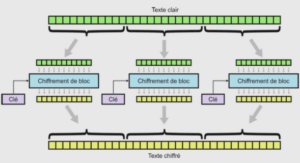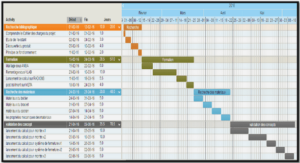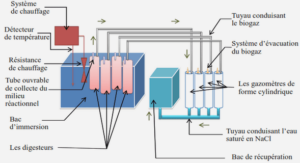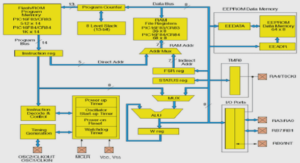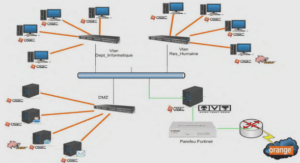Objectives of this Thesis
The main objective of this thesis is to develop an efficient and accurate method of ECG beat classification. The latter must be able to classify six types of heart beat, namely normal beats (NBs), premature ventricular contractions (PVCs), paced beats (PBs), atrial premature beats (APBs), left bundle branch block beats (LBBBs), and right bundle branch block beats (RBBBs). The second main point is to localise in real time ECG QRS complexes that indicate normal heart beats (thus localizing abnormal ones). Theses objectives are achieved by following some steps:
1. ECG signal noise reduction: ECG recordings are generally corrupted by noise from various sources. Then techniques of low-frequency and high-frequency noise cancellation based on wavelet transformation (which is a powerful tool for non-stationary signal analysis) have been used.
2. Morphological Feature Extraction: Significant information from ECG signals are extracted. Also the power of wavelet approximation have been used to dimmensionnaly reduce the amount of information to analyse.
3. Exploitation of (patient) specificities: The classification method developped in this thesis is patient-adaptable. A database of patient annotated heart beats have been build. A clustering method has also been used to emphasize patient specificities carried by the ECG signal.
4. Analysis: After extracting morphological features and exploiting patient spécificities, analysis to classify and to localise heart beats has been done.
What is an Electrocardiograms ?
With the invention of the string galvanometer by the Dutch physiologist, W. Einthoven,the electrocardiogram has become a valuable tool of studying the electrical activity of the heart. The heart is the muscular organ located in the chest between the lungs which, with regular rhythmic contractions cause blood to circulate throughout the body (see figure 2.1 for an anatomy). The electrocardiogram, also called ECG signal is a biological signal which is recorded from electrodes placed on the body surface. It represents the electrical activity of the heart, which is at the origin of the cardiac muscle contraction that results to the propel of the blood from vena cavas to aorta and pulmonary artery.
The P wave
The P wave represents the sequential activation of the right and left atria. Its normal duration is between 0.08 and 0.12s. Its amplitude must be less than 2.5 mV [22]. The shape of the P wave is smooth and entirely positive.
Right Bundle Branch Block (RBBB)
The right bundle branch block occurs when the right ventricle is depolarized after the left ventricle. This happens when the transmission of the electrical impulse is delayed or not conducted along the right bundle branch, however, the left ventricle is normally activated by the left bundle branch. In normal beats the QRS complex is narrow (< 0.1s) because the two ventricles (left and right) receive the electrical impulse at the same time. While in the RBBB the right ventricle receives the electrical impulse after the left ventricle. Therefore the QRS complex is widen. In the « incomplete » RBBB has a QRS duration of 0.10 to 0.12s, the QRS complex of the « Complete » RBBB can be greater than 0.12s [22].
Left Bundle Branch Block (LBBB)
The left Left bundle branch block is the opposite of Light bundle branch block. Here the left ventricle is depolarized after the right ventricle. But LBBB is usually associated with increased rate of mortality than RBBB. While RBBB often occurs in young patient without apparent organic heart disease, LBBB is more often encountered in older patients and indicates underlying cardiac pathology such as dilated cardiomyopathy, hypertrophic cardiomyopathy, hypertension, aortic valve disease, coronary artery disease.
Premature Ventricular Beat (PVC)
Premature ventricular contractions are heart beats originating from the ventricles rather than from the sinoatrial node which is the initiator of the normal beats. Premature ventricular contractions are premature beats because they occur before the regular heart beat. Morphologically PVCs are characterized by QRS complexes usually wider than 0.12s. These complexes are not preceded by a P wave, and the T wave is usually large, and its direction is opposite the major deflection of the QRS. PVCs can occur as single or repetitive events. Usually a PVC is followed by a complete compensatory pause; i.e., the interval from sinus to premature ventricular beat plus the next sinus beat measures two sinus cycles (see Figure 2.15) [22]. PVCs are usually not associated with any increased rate of mortality, but the presence of high PVC frequencies (> 20 per hour or > 10 per thousand beats) can lead to sudden coronary death[30].
ECG noise reduction techniques
Many denoising techniques are proposed in the literature. There are adaptive scheme methods based on the Least Means Square algorithm (LMS) such as, “The adaptive impluse correlated filter (AICF)” proposed by Thakor an Zhu [64], and “The time-sequenced adaptive filter (TSAF)” [65] which show good performances but not always. But “The single-input adaptive filter” based on the first two is robust to noise and gives good denoising results [66]. There are also methods based window averaging such as the one proposed by H. SadAbadi [67], but it’s not easy to implement. Currently in the ECG denoising area there’s a growing interest in methods that use the wavelet transformation. Several recent work based on wavelet transform had shown good denoising results [68, 69, 70, 71]. After the choice of the type of wavelet and the thresholding parameters, the denoising technique was performed by the following steps: do a forward discrete wavelet transform up to some resolution level, do a soft thresholding on the wavelet coefficients and finish with an inverse discrete wavelet transform.
|
Table des matières
Résumé en français
0.1 Introduction
0.2 Méthodes de classification et de localisation proposées
0.2.1 Décomposition en ondelettes
0.2.2 Débruitage du signal ECG
0.2.3 Classification
0.2.4 Localisation
0.3 Application et résultats obtenus
0.4 Conclusion
1 Introduction
1.1 Objectives of this Thesis
1.2 Organization of the Thesis
2 Electrocardiograms (ECG)
2.1 What is an Electrocardiograms ?
2.2 Characteristics of the normal ECG
2.2.1 The P wave
2.2.2 The PR interval
2.2.3 The QRS complex
2.2.4 The ST segment
2.2.5 The QT interval
2.2.6 The T wave
2.2.7 Morphology of the normal ECG
2.3 ECG abnormalities
2.4 The MIT-BIH arrhythmia database
3 Wavelets
3.1 Multiresolution analysis
3.2 The Haar wavelet
3.3 The cascade algorithm
4 ECG beat classification
4.1 Introduction
4.2 ECG signal pre-processing
4.2.1 ECG noise reduction techniques
4.3 Proposed method
4.3.1 Feature extraction
4.3.2 Similarity function
4.3.3 Clustering algorithm
4.3.4 Classification
4.4 Results and discussion
4.5 Conclusion
5 Automated localisation
5.1 Introduction
5.2 QRS detection algorithms
5.3 Analysis
5.3.1 The parsimonious wavelet analysis of ECG signals
5.3.2 Marking the points of interest
5.3.3 QRS mask and recognition of the shape of the QRS complex
5.4 Summary of the results
5.4.1 Qualitative localisation of marked points
5.4.2 Shape recognition of the normal QRS complexes
5.4.3 Comments on specific files
5.4.4 Computational complexity
5.5 Conclusion
6 Conclusion and future work
Bibliography
![]() Télécharger le rapport complet
Télécharger le rapport complet

